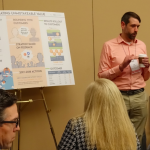

What?
We teach a results rollout process to our partners that leaders use to present survey results and collect input for action planning. The process also applies to any results that organizations receive that are important to communicate with employees. The better we communicate the results, the greater opportunity we have to create a team approach to problem-solving.
We train leaders to explain the results of the survey to their employees, celebrate the wins, and ask for input on ways to improve. The survey rollout process teaches leaders to develop key words and actions for the survey rollout meeting they will have with their staff.
As part of the rollout process, leaders hold meetings with staff to present the highest-scored items and for leaders to ask staff why those items yielded the best results. Then, leaders present the lowest-scored items, ask why staff members think the items showed the least improvement, and invite suggestions for improving those areas. The leaders complete the meeting by gaining input on one or two action items to apply over the next 60 to 75 days.
Why?
We’ve found that about 95% of the time, when leaders have the proper training in using key words during the rollout process, employees rank the leaders highly on items related to communication, feedback, and input. This boosts leaders’ self confidence as they continue to engage with employees to work toward achieving their unit goals.
Some news from the survey results unsettles us. Our own experiences tell us it’s difficult to rollout unfavorable results. The problems seem overwhelming, and the negative information is upsetting. However, once rolled out, everyone sees that many problems have been narrowed down to two or three that can be solved with a good action plan. For example, the top two issues might be work pressure and communication issues. After the rollout meeting, we have insight into how employees define these two barriers and what they expect to see. Also, the employees’ input determines the top priorities that need to be addressed.
How?
If leaders receive bad results, they might say something like:
The employee engagement results are back. Thank you for completing the survey. I want to tell you that I’m disappointed. Obviously I’m not the leader I want to be. But I want you to know that I’m committed to making this a better organization and to being a good leader. I hope you’ll help me.
Once you say, “I hope you’ll help me,” most of the team will be on your side. A big part of the results rollout discussion is about the ability to be open about the results.
At the end of the meeting, we administer an evaluation of the meeting. Here, our teams provide us with feedback on the results rollout meeting. The entire rollout process is about improvement.
Asti Kelley, Studer Education℠
Excerpt from: Maximize Performance



[…] the impact. As part of the change initiative, IPF increased investment in Employee Engagement and Survey Results Rollout to help facilitate conversations about the data and get input from those who’s jobs were […]